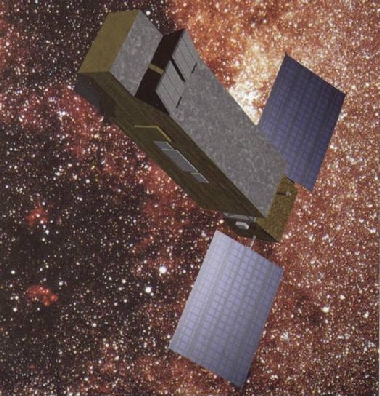

Mission Status Report #64 Star Date: Jan. 13, 2003
Another Year CompletedCaption: Graphic showing how FUSE would look on-orbit. The telescopes are looking toward the upper left in this picture, and only two of the four telescope doors are visible from this angle. The blue rectangles represent the solar panels, which connect to the spacecraft at the bottom. As the background shows, there are a LOT of stars out there for FUSE to look at! (Figure courtesy JHU FUSE project.)
I am happy to report that operations with FUSE continue to go smoothly at this writing. The close of 2002 marked another banner year for the mission, with over 9.2 million seconds of scientific observations garnered during the year. This is about 300,000 seconds more data than achieved during the previous cycle of observing, a feat made even more impressive because most of January 2002 was spent recovering from reaction wheel problems. Speaking of reaction wheels, those of you who follow these reports closely probably saw the addendum to last month's report. In December 2002, we experienced a temporary glitch with one of our two remaining reaction wheels. In response to that situation, we have modified our operations in such a way that we keep the two remaining wheels "biased" (meaning we intentionally keep them spinning at a rapid rate) to avoid problems. To accommodate this way of operating, we have also slowed the rate we allow FUSE to move when it is changing between targets. Both of these changes will be transparent to users of FUSE; data quality will be unaffected. Final preparations and testing of new flight software are ongoing for expected uplink in February 2003. This new software is designed to allow FUSE operations to continue smoothly even if some of our laser-ring gyroscopes fail with age. At the moment, 5 out of 6 original gyros are still operational, but 3 are needed (one on each of our 3 primary axes). With the new software, FUSE will use whatever gyro information is available as long as it is available, but will continue operating with new methods if and when any gyros fail. (Thanks to our clever engineers and contractors for figuring out a way to do this!) Since there are no "consumables" on FUSE, fixing this potential problem before it happens means that FUSE should be able to operate for many more years to come. It will, however, require a period of down time while the new software is uplinked and tested on the real satellite. It is a trade well worth it! The selection of Cycle 4 observing programs is nearing completion, and NASA plans to announce the results of the selections in the next few weeks. These new observations will start being scheduled in April 2003 and continue for the following year. The team here at Hopkins looks forward to implementing another year of exciting science observations with the FUSE satellite!
Reported by: Bill Blair, Chief of Observatory Operations
|
